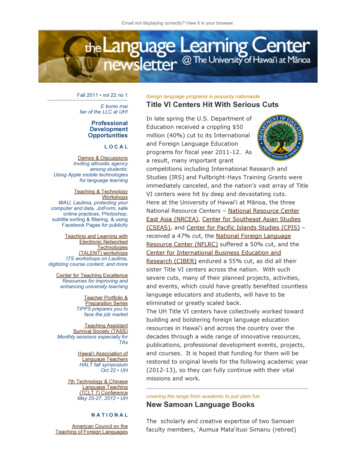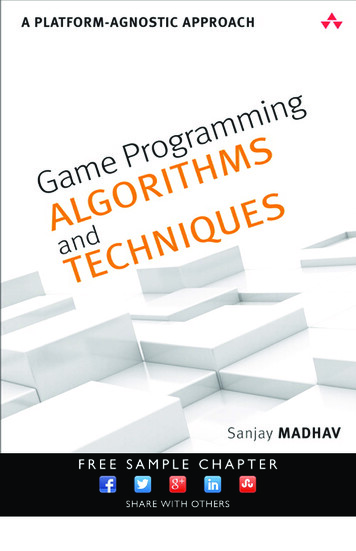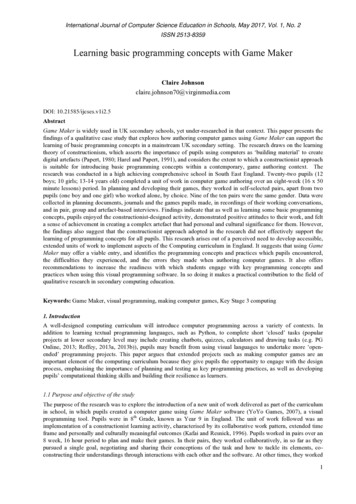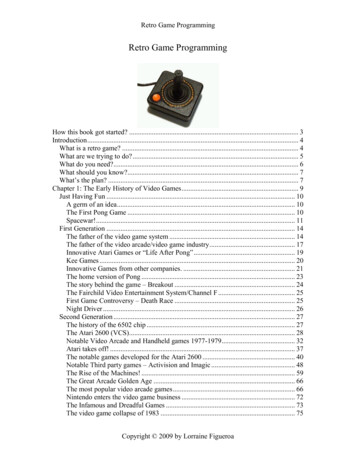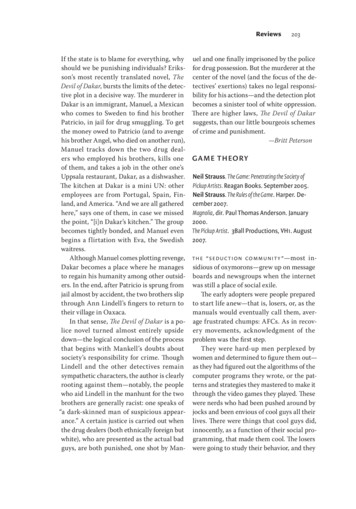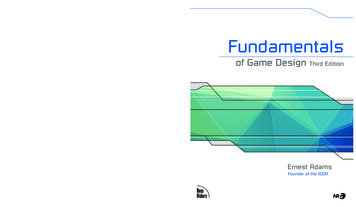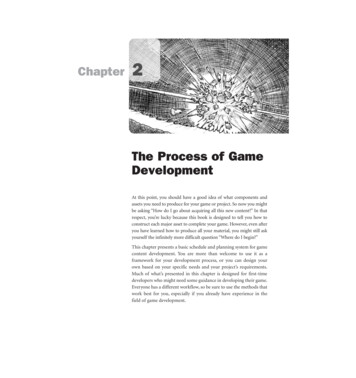
Transcription
Healthcare gamificationSerious game about COVID-19;Stay at home.María López HernándezInteraction designTwo-year master15 creditsSpring 2020 – Semester 2Supervisor: Dario Salvi
ABSTRACTSerious games are games whose primary aspirations go beyond pure entertainment. With adistinct learning agenda, they encourage learning through interaction with real-world issues.This research of this thesis was aimed at evaluating serious games as an effective educationaltool to teach young adults about prevention measures that could mitigate the spread of COVID-19.The design process combines game research methods with qualitative and quantitative meansto evaluate people’s attitudes and knowledge gain towards the problem domain. The resultof this design process, is Stay at Home, a serious game containing different microgames thatteach the target group about guidelines and recommended prevention and hygiene measures against the virus. Playtesting the game revealed a small gain and slight change in player’sattitudes. The game requires further adjustments to enhance playability and player engagement, but offers a promising approach to educate an age-group through a highly interactivemedium.2
INDEX1. OUTLINE 51.1 Introduction 51.2 Research Question 61.3 Ethical considerations6.5.2.BACKGROUND AND THEORY 72.1 Symptoms2.1.1 Guidelines and recommendations2.1.2 The Impact of Online Information during COVID-192.1.3 Human Behavior During Pandemics2.1.4 Target audience2.2. Gamification2.2.1 Gamification and Games2.2.3 Serious Games for Health2.2.4 Learning benefits expected from Serious Games2.2.5 Evaluating serious games in education2.3. Canonical Examples2.3.1 Plague Inc.2.8.2 The great flu2.8.3 Stop the Spread! e-Bug Junior2.8.4 Pandemic2.8.5 Canonical examples conclusion77888991010111212131314143.1 Project plan3.2 Double Diamond3.1.1 Discover3.1.2 Define3.1.3 Develop3.1.4 Deliver3.2 Human-centered design research3.3 Play-centric design3.4 Unstructered interviews3.5 Secondary Research & Survey3.6 Cultural Probes & Gamestorming3.7 Playtesting Methods1616171717171818181819204.1 Discover4.1.1 Preliminary overview4.1.2 Unstructured Interviews4.1.3 Secondary Research & Netnography4.1.4 Survey4.1.5 Insights survey4.1.6 Conclusion212121212222223. METHODS 164. DESIGN PROCESS 213
4.2 Define234.2.2 Cultural Probe234.2.3 Conclusion274.3 Develop284.3.1 Sketching and Prototyping 284.3.2 Player Testing low-fi 284.3.3 User scenarios 304.4 Deliver314.4.1 Hi-fi Prototyping Concept 314.4.2 Methods playertesting335.MAIN RESULTS AND FINAL DESIGN 345.1 Qualitative Results345.2.Quantitative Results 366. DISCUSSION 377. CONCLUSION 387.1 Contribution to Interaction Design 397.2 Future Work 398. ACKNOWLEDGEMENTS 399.REFERENCES 4010. APPENDIX 444
1.OUTLINE1.1IntroductionIn December 2019, a pneumonia outbreak of unknown etiology in Wuhan, China, quicklyspread worldwide. Chinese Center for Disease Control and Prevention (CCDC) identified anovel beta-coronavirus called 2019-nCoV, now officially known as Severe Acute RespiratorySyndrome Coronavirus 2 (SARS-CoV-2) (Gorbalenya et al., 2020). The rapid spread of thisvirus has become a global threat to our society and our lives. Since the World Health Organization (WHO) declared SARS-CoV-2, also known as COVID-19, a pandemic on March 11,2020, COVID-19 has led to the implementation of extraordinary public health measures toreduce further spread within China and elsewhere. In the middle of a health crisis, everythingnormal about our daily lives is being put on hold, jeopardizing our personal and professionallives and our physical and mental well-being. However, despite the restrictions and the termsthat the virus is dictating in our lives, comparatively young and healthy individuals may thinkthey are unlikely to get sick, let alone die. Recent events, testimonies, and reports relating tothis group suggest that the message has not been getting through to everyone.This leads us to assume that existing mediums of information either lack efficiency or havebeen unable to engage specific audience demographics sufficiently as a resource on pandemic-related knowledge. The goal of this thesis is to create a channel of information, a seriousgame, which refines and repackages crucial knowledge on pandemics through gamification,to engage and educate demographics that haven’t been influenced sufficiently by existingchannels. According to Corti, (2006), game-based learning or serious games are “all aboutleveraging the power of computer games to captivate and engage end-users for a specific purpose, such as to develop new knowledge and skills.”(Corti, 2006). It has been used successfullyin further educational contexts, even healthcare. According to Roubidoux et al. (2009), manyserious games in the area of e-health have been developed, which deal with a wide variety offeatures for patient care.This thesis is divided into six chapters. The first chapter consists of the theoretical groundingand research used to frame the game design - context of COVID-19, measures to contain thecontagion, serious games for healthcare to create awareness and educational games, and designing. The second chapter introduces four types of serious games that served as inspirationsand references for the game’s design. The third chapter elucidates on the double diamond model used to design the game to understand how the design process was chosen and why. Thefourth chapter, the core of the thesis, goes through each method and process, elaborates ondesign decisions, and how it was relevant to the final prototype and evaluation. The fifth chapter shows results from the game evaluation and assesses whether the design process was fruitful concerning the game. In the last chapters, future work and design openings are explored.5
1.2 Research QuestionHow can serious games be used as an educational tool to raise awareness about the risksof pandemics to contain the expansion of COVID-19?1.3 Ethical considerationsNames and information of users who participated in interviews, play-testing, and culturalprobes will be protected and not shared in this report, as stated in the participation agreementin Appendix 1. Future photographs that appear in the project have been reviewed and accepted by the subjects that appear on them.6
2.BACKGROUND & THEORY2.1. COVID-19: Context, Symptoms and Modes of TransmissionPreceding outbreaks of coronaviruses (CoVs) cover the Severe Acute Respiratory Syndrome (SARS)-CoV and (MERS)-CoV, Middle East Respiratory Syndrome, which has been previously characterized as agents of an enormous public health threat (Shereen, Khan, Kazmi,Bashir & Siddique, 2020).SARS-CoV-2 is a distinct strain of coronavirus that has not been previously identified in humans. The incubation period of this strain is unknown. Still, the United States Center forDisease Control and Prevention and World Health Organization (WHO, 2020) indicate thatsymptoms may arise in as few as two days or as long as 14 days after exposure. However, someliterature suggests that the incubation period can persist longer than two weeks, and it is feasible that a longer incubation period could reflect double exposure (Han et al. 2020). Whatmakes this pandemic dangerous is that analysis suggests that half of all transmissions occur inthe early stages of the infection, before it even reveals any symptoms of the disease, i.e., whenpatients are asymptomatic (Gorbalenya et al., 2020).According to the WHO (2020), the most common symptoms of COVID-19 illness are fever,and fatigue and cough, while other symptoms include sputum production, headache, haemoptysis, diarrhoea, dyspnoea, and lymphopenia.Since there is no current vaccine or antivirals available for treatment, according to WHO(2020), the application of preventive measures is essential for mitigating the spread of thevirus worldwide. As stated by WHO (2020), persons over 65 years of age are more susceptibleto severe coronavirus infections. Other high-risk demographics are individuals with pre-existing conditions that significantly impair the functioning of the lungs, heart or immune system, severe heart disease, lung disease that is not clinically stabilized,, chronic liver or kidneyfailure, diabetes that involves organ damage, diseases that weaken the immune system suchas leukemia or lymphoma, and even medication which significantly weakens the immunesystem as a side-effect.Transmission of the COVID-19 virus can arise by staying in direct contact (within 1 m) ofinfected people and indirect contact with surfaces in the immediate environment or withobjects used on the infected person. According to WHO (2020), airborne transmission isalso highly plausible. It may also be possible in specific circumstances and settings whereprocedures or support treatments that generate aerosols are performed - bronchoscopy, opensuctioning, the patient to the prone position, disconnecting the patient from the ventilator,cardiopulmonary resuscitation.2.1.1 Guidelines and recommendationsAccording to the WHO (2020), some of the guidelines and measures to contain the contagionof the virus may include:1)Avoiding physical contact while greeting; safe greetings include a wave, a nod or a bow.2)Cover the nose and mouth with tissue or a bent elbow when sneezing or coughing , andimmediately disposing of the used tissue.3)Washing one’s hands regularly with soap and water or using alcohol-based rub for at leasttwenty seconds.4)Keeping distance of at least 1 metre from someone who is coughing or sneezing, as well askeeping enough distance in public places. The minimal distance recommended is 1.5 metres.5)In presence of cough, fever, and difficulty in breathing, one must wear a mask correctly andseek medical advice. Many countries have prohibitions of public gatherings of more than 507
people. It is important that in case of self-isolation, to not visit other people’s homes or socialize outside one’s home. If unwell, one must isolate themselves and their family. Citizensbelonging to countries with no restrictions on outdoor movement are recommended to onlyleave home for essentials, shopping, medical needs and exercise once a day.2.1.2 The Impact of Online Information during COVID-19On the internet, people have access to an endless stream of information regarding the COVID-19 pandemic outbreak. Not only that, but through social media, people have also spreadand shared news and articles as well as their own experiences about the pandemic, allowingimmediate access to global development (Farooq, Laato & Islam, 2020). Although the vastamount of online data can be useful for artificial intelligence and machine learning algorithms, it can pose a large number of difficulties for individuals to grasp. As stated by thesame authors, two main problems can appear from excessive internet use during a worldwidepandemic. The first is cyberchondria, defined as an obsessive online searching behaviour foronline health-related information. The second is an information overload, which is when aperson cannot process all the communication and informational inputs. As a result, the information gathering process remains ineffective. Both problems, cyberchondria, and information overload have been proven to weaken human cognitive reasoning, according to Starcevicand Berle, (2013).2.1.3 Human Behaviour During PandemicsWhen the amount of knowledge crosses one’s processing capacities, the cognitive load theorypostulates that the natural human reaction in such situations is to take a step away from thesource of the information overload. Information overload distorts people’s belief systems,particularly coping appraisal during a pandemic. In particular, information overload negatively affects self-efficacy and positively influences response costs. Moreover, cyberchondriachanged the perceptions of perceived difficulty and perceived vulnerability, affecting people’sthreat assessment during pandemics, such as COVID-19. Although cyberchondria is generally regarded to be negative, in the case of COVID-19, it might help individuals to grasp theactual gravity of the situation. It is important to note that although people with cyberchondriamay be first adopters of self-isolation behaviour, they can, in the long run, suffer from stressand anxiety due to regularly seeing news highlighting the severity of the situation, (Farooq,Laato & Islam, 2020).2.1.4 Target audienceSarah T. Stahl (2013) states that there is an association between perceived vulnerability todisease, aging knowledge, and ageism. Due to continuous reporting, older adults are likely tobe at higher risk. Information bias occurs, causing many young adults to consider not takingthe threat of the virus seriously. This bias is compounded by the observation that young adultshave significantly lower mortality rates and are more likely to contract a moderate case of thevirus than older adults. This information bias makes young adults more likely to ignore orflout crucial regulations against the pandemic. When coupled with the long incubation periodof the virus, it makes young adults ideal conduits for spreading viruses to high-risk groupsin their vicinity, or worse, makes them more likely to be super-spreaders. Thus, in this thesis,young adults are the target audience.8
2.2 Gamification2.2.1 Gamification and GamesThe term ‘gamification’ is utilized to describe the application of game mechanics or motivational techniques in a non-game environment (Lee and Hammer, 2011) or as (Deterding etal., 2011, p.9) suggest “the use of game design elements in non-game contexts.” By this definition, game is a structured, goal-oriented effort, in contrast, to play, which may lack clearboundaries and goals. Or, as (Deterding, 2011; Zhang, 2008) have suggested, the underlyingidea of gamification is to use the specific design features or “motivational affordances of entertainment games in other systems to
OUTLINE 5 1.1 odrucnt ioInt 5 .5. 1.2 Research Question 6 . del used to design the game to understand how the design process was chosen and why. The fourth chapter, the core of the thesis, goes through each method and process, elaborates on design decisions, and how it was relevant to the final prototype and evaluation. The fifth chap - ter shows results from the game evaluation and assesses .
